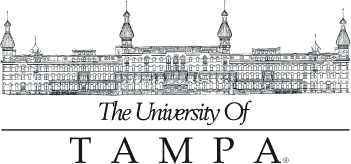The University of Tampa would not be the thriving institution it is today without the leadership of the 10 individuals who have taken on the role of its president.
"I have a vision wherein I see it grown into a fine four-year college, not large in numbers, but holding to the highest ideals academically and spiritually. I can see it filling a much needed place in Tampa through the years, free to work out a great future unencumbered, progressive, alert and endowed with a spirit of service applied in a practical and efficient manner." - Frederic Spaulding

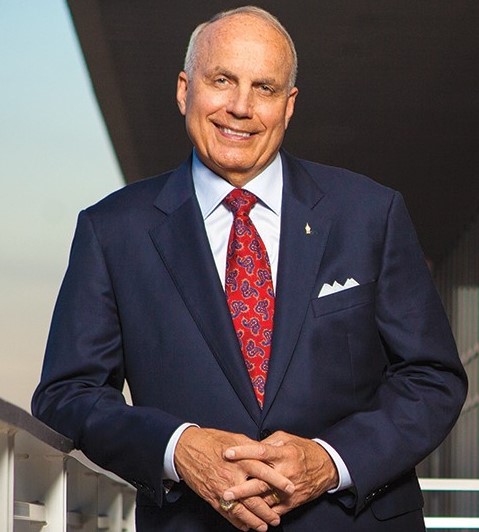 | RONALD L. VAUGHN Under Vaughn's leadership, the University grew and expanded in a way that's unlike any period in the institution's history. During his tenure, University full-time enrollments more than quadrupled, new enrollment records were regularly set and academic programs were expanded to more than 200 areas of study. Since 1995, the University’s annual budget increased by over 10 times from $28 million to $380 million. The record growth fueled dynamic improvements in both the academic and student life areas. President Vaughn came to UT in August 1984 as the coordinator of the marketing department and holder of the Max H. Hollingsworth Endowed Chair of American Enterprise. He also served as director of the MBA program, dean of the College of Business and Graduate Studies and co-chief academic officer. He has a bachelor’s degree in marketing and an MBA from Indiana State University, and a doctorate in marketing from the University of Georgia. He also owned his own multi-office marketing research/consulting company where he worked on several hundred projects for a broad clientele. On March 24, 2023, Vaughn announced his retirement in May 2024. "lt’s been the greatest honor of my life to lead this incredible University,” Vaughn said. |
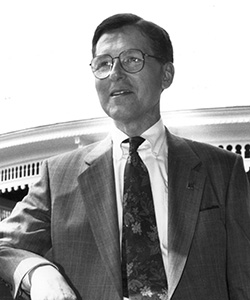 |
Born in Archbold, OH, Ruffer was educated at Defiance College, Bowling Green State University and the University of Oklahoma. He and his wife, Marilyn, were college sweethearts and had three children together. Ruffer's son, David Geoffrey Ruffer '94, is a UT alumnus. Before coming to UT, Ruffer served as president of Albright College in Pennsylvania for 31 years. In his first year as UT's president, Ruffer supported a gay student's right to take a ROTC leadership course. According to the Gainesville Sun, he said, "This is not an issue of sexual preference... it's an issue of academic freedom. We do not discriminate here. In fact, it would be illegal to do so." His goal as president was to help UT to become a great, selective liberal arts university, but he was soon grappling with declining enrollment and budget deficits. According to the Zionsville Times Sentinel (IN), he lives in Zionsville, IN, where he volunteers at PH Sullivan Museum. |
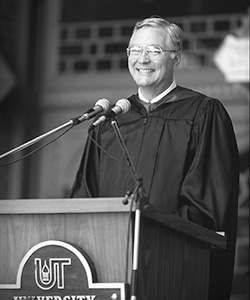 | BRUCE A. SAMSON A Tampa native, Samson earned degrees from the University of the South and Harvard Business School. Before coming to UT, he worked at H.G. Nix Inc., an investment banking firm specializing in governmental finance. Samson was appointed by Gov. Bob Graham to the Southwest Florida Water Management District (often referred to as Swift-mud) and served as its chairman. Just before he was offered the presidency at UT, Samson considered running for mayor of Tampa. UT was $1.7 million in the red when Samson took over. Within a year, the University had a surplus and stayed in the black throughout his administration. Samson also raised money to restore the minarets from the peeling gold paint of Cheshire's administration. During his tenure, Samson established the College of Business and the College of Liberal Arts. |
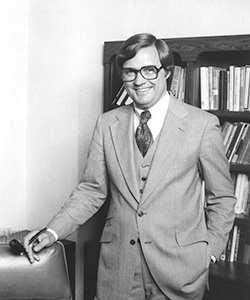 | RICHARD D. CHESHIRE Cheshire was educated at Colgate University, the University of New Hampshire, and New York University. He and his wife, Roberta ("Bobbie"), and their three children were the last presidential family to live in Barritt House, which was located in the Palma Ceia section of Tampa and had been the home of UT presidents since 1967. Cheshire's single most important goal during his administration was raising the academic level of the University, telling the Tampa Tribune, "I heard that this place had an image of having rich dumb kids from the North." During his time as president, the average SAT score for freshmen increased 10.8% from 1977 to 1985. He also established the Collegium, a policy review group comprised of faculty, staff and students whose purpose was "to enhance competent and rational decision-making in matters of institutional program policy and practice." Cheshire authorized painting Plant Hall's minarets gold for the University's 50th anniversary. Unfortunately, the paint started peeling after six months. |
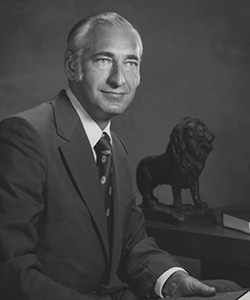 | B.D. OWENS Owens was born in Grant City, MO, and educated at Northwest Missouri State University and the University of Pennsylvania. Owens served for five years in the Air Force and Missouri National Guard. During a flight in 1957, he experienced a flame-out shortly after takeoff and was forced to land in an adjacent field. He and his one passenger walked away unscathed. Just 36 when he took office, Owens is the youngest president in UT's history. During his administration, Owens established the ROTC program (1971) and started the University's first graduate program, the Master of Business Administration and Master of Education (1973). In 1971, he traded land north of the University for the Fairgrounds. Though UT's football program was popular, according to reports it was pushing the University toward bankruptcy and was terminated in February 1975. The Reading Eagle (PA) newspaper reported in 1976, "the community was enraged. A threat on Owens' life brought protection from University and city police." In January 1977, Owens resigned to become president of his alma mater, North-west Missouri State University, where the B.D. Owens Library is named for him. |
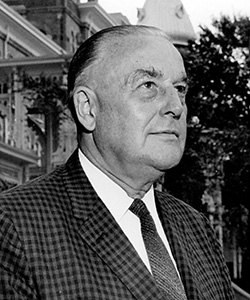 | DAVID M. DELO A native of Morris, IL, Delo was the son of a Lutheran minister and credited this with giving him "a little missionary spirit" (Tampa Tribune, Sept. 15, 1968). This spirit helped him transform UT from an institution where most students were commuters, to less than 30% commuter students in 10 years. Delo was educated at Miami University (OH), the University of Kansas, and Harvard University. He married his first wife, known as Sunny, while at Harvard and the couple had four children. (After Sunny's death he married twice more.) Delo was the first UT president to have a proper inauguration. During his administration, Delo increased the physical plant of the University and added six major dormitories. Other additions to campus included Falk Theatre, the University Union (now Riverside Center), McKay Auditorium (now Sykes College of Business), and the Merle Kelce Library (now Macdonald-Kelce Library). Delo watched the faculty closely and frowned upon them wearing beards. When Delo retired in 1971, he served as the University's first and only chancellor for two years. He passed away on Oct. 31, 2004. |
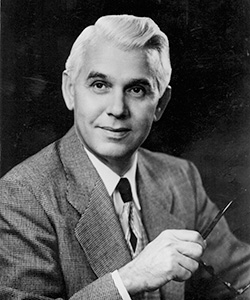 | ELLWOOD C. NANCE Nance was born in Ashland, KY, and educated at the Christian Normal Institution, Heidelberg College, Ohio State University, Kentucky Christian College, and Oberlin Graduate School of Theology. Ordained in 1926, Nance spent 17 years in ministry. He and his wife, Margaret, had two children. He was 16 when he joined the Army and served for three years in World War I. During World War II, he served as a combat chaplain aboard the U.S.S. Catoctin in the European Theatre. By the time he was named president, most of the faculty knew Nance, either personally or by reputation. The first day of his presidency was May 8, 1945, which is also known as VE Day. Nance's crowning achievement as president came on Dec. 6, 1951, when UT was accepted as a member of the Southern Association of Colleges. Nance canceled classes for the rest of the week in celebration of the University's accreditation. Nance reportedly liked to hobnob with celebrities and is pictured welcoming film and stage actor Tyrone Power to Tampa. Nance died on May 27, 1965. |
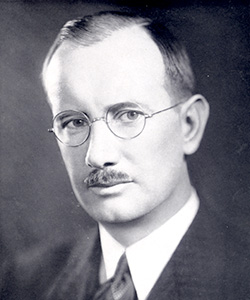 | JAMES ELLIOTT MOONEY Mooney was born in Dansville, NY, and educated at several colleges and universities, including the New York State Teachers College, Duquesne University, Beaver College, and Rider College. He and his wife, Mildred, had four children. His son, James Elliot Mooney Jr., enrolled at UT at age 16. Due to the war effort, during his administration, there was a shift away from standard liberal arts studies to courses suitable for wartime. During the peak war years, UT's enrollment declined from 356 to 171, consisting of mostly women, sparking rumors that the University would close. Mooney also expanded the lease on the Tampa Bay Hotel to 99 years. After he resigned as president, Mooney became head of the aviation bureau in Pinellas County. He later served as deputy U.S. Antarctic projects officer from 1959-1965. Mooney was friends with World War I hero Eddie Rickenbacker and aviator and explorer Richard Evelyn Byrd. Byrd even named a mountain in Antarctica after Mooney. Mount Mooney rises 9,350 feet above the middle of Robison Glacier in the Queen Maud Mountains. Mooney passed away on Oct. 30, 1968. |
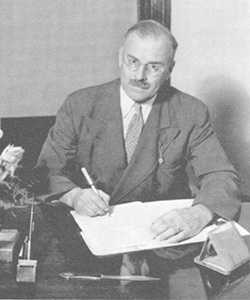 | JOHN HARVEY SHERMAN A native of Ashgrove, VA, Sherman earned degrees from Cornell University and the University of Wisconsin. Before coming to UT, he served in World War I and practiced law in Chicago. Sherman and his wife, Mary, had five children, and his son, John H. Sherman Jr. '40, is a UT graduate. During his administration, Sherman reduced faculty turnover, removed courses from the catalog the University couldn't offer and decreased teaching loads to bring them in line with the Southern Association of Colleges standard. In 1939, Sherman was visited by the German consul for the Southeast United States and offered books for the library if he would fire a German professor who was critical of Hitler's regime. He politely refused, but Sherman later told the New York Times, "I was sorry later I didn't kick him out of my office." Sherman left UT in 1940 to become president of Webber College in Babson Park, FL, and later served in World War II. He was a colonel when he retired from the Army. He died in 1981, and is buried in Arlington National Cemetery. |
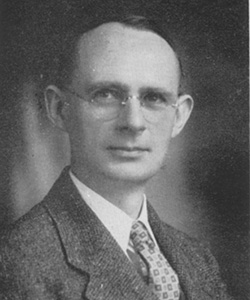 | FREDERIC H. SPAULDING Born in Norridgewock, ME, Spaulding had degrees from Bates Colege and Harvard University. He served in World War I in the chemical warfare service. Of starting Tampa Junior College, which would become The University of Tampa two years later, Spaulding wrote, "The immediate challenge in the beginning was to get the show on the road." He and his wife, Helen, had two sons, Frederick and David. The family moved into the Tampa Bay Hotel along with the fledging University in August 1933 and lived in a seven-room apartment on the second floor for two years. The University's original lease for the building was for $1 a year for 10 years. Spaulding was one of two spectators at UT's first football game against Rollins College. He and board member George B. Howell cheered on the team in the grand stands at Plant Field. Spaulding died on March 6, 1974. |

